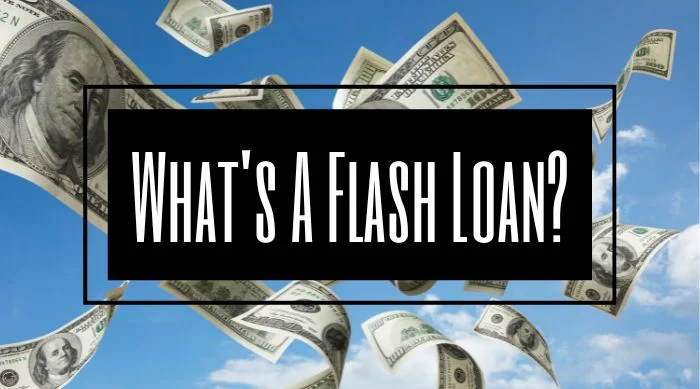Flash loans are a unique option in decentralized finance or DeFi; a flash loan is one that is issued on the blockchain using a smart contract. These loans don’t require collateral, credit checks, or other preliminaries.
That sounds a bit scary to some; potential warning signs of a scam. But flash loans are NOT repaid over time like 24 or 26 months. They are issued and paid off “immediately” according to the terms specified in the smart contract and no funds are released until all smart contract conditions are met.

You must agree to repay the loan via the specific terms spelled out between lender and borrower in the smart contract or the funds do not get released.
Why would anyone want or need to borrow money they have to repay instantly? That’s one of the “deep cuts” on the investing playlist, so to speak. There are specific reasons why you would want a flash loan and most of them have to do with earning money.
What Is A Flash Loan Good For?
At least one source credits The Marble Protocol for innovating flash loans on the Ethereum blockchain back in 2019. The motivation was simple; lenders share risk when they offer credit.
One risk involves lending money and not getting it back, the other involves not having enough liquidity due to over-loaning and not being paid back on time. Flash loans eliminate both risks, at least on paper.
But flash loans aren’t good for all purposes. For example, you wouldn’t purchase office equipment or home entertainment systems with a flash loan.
Instead, you would use a flash loan for a very specific type of purchase or transfer such as taking advantage of a pricing discrepancy between the price of a coin or virtual currency on different exchanges.
That’s a situation where using a flash loan works; buy on one exchange at a lower rate, and sell on another exchange at the higher rate listed there. Then you repay the flash loan and count the profit. Assuming you are able to buy and sell within the specified repayment period, it sounds fairly simple, doesn’t it?
How Do Flash Loans Work?
Flash loans are executed by smart contracts, which reside on a blockchain. The loan is executed when all parameters specified are met. Flash loans are “instant loans” and require repayment before the smart contract transaction ends. From the outside looking in, that sounds like two people just trading money from one hand to the other.
This is where flash loans get a bit complex. Because the loans are executed using smart contracts, you can use another smart contract or set of them to execute trades using the loan funds.
While the loan contract and your purchase contracts are separate, they are meant to happen instantly. The time between getting your loan and making your investment is almost nonexistent, at least in theory.
Note that there’s no provision for the borrower manually executing a purchase with the loan funds. That is typically not possible given the instantaneous nature of flash loans. The loan is canceled if all conditions are not met. Missing the deadline for repayment is one of those conditions.
What does all this mean? Essentially, if you have no experience with smart contracts, you are at a huge disadvantage when it comes to a smart loan. If you know what you are doing with them, smart loans could be a resource to use when a specific opportunity arises.
Uses For Flash Loans
In addition to the crypto purchasing option (mentioned above) you can also use a flash loan to perform something called a collateral swap. This is where you take out a loan on one platform using crypto as collateral, and later use a flash loan to pay off the loan and reclaim their currency. Does that sound confusing?
Step One: Borrowing money from a defi lender and putting up crypto as collateral. Note that this loan is NOT a flash loan.
Step Two: Obtain a flash loan and use smart contracts to pay off the first loan, and cash out the crypto collateral at the same time.
Step Three: Use a smart contract to send the proceeds of your reclaimed collateral to pay off the flash loan.
Step Three: Pocket any excess funds after the flash loan is paid off.
This is an oversimplified explanation and does not get into the nuances of creating smart contracts or the difficulty level of doing so. If you have to ask, “What is a smart contract?” You likely aren’t ready to try a flash loan.
Debt refinancing is another use of flash loans. This is associated with refinancing specifically to get a more competitive interest rate.
The process is the same; you use a flash loan to pay back debt on one platform, get your collateral back, and use it to get a lower-interest loan minted on a new platform, and return funds back to the flash lender. In each step of the process, smart contracts are used to make the transactions happen instantly.
Things To Know About Flash Loans
The rules of a flash loan make them sound nearly hacker-proof. Except that is never true and flash loans have a particular vulnerability in a few different areas.
A flash loan attack is one approach some scammers use to trick a lender into thinking a loan has been repaid. This can be done by artificially inflating the value of a coin paid back to the lender, making it seem like full value was repaid when it was not.
This could be done by exploiting vulnerabilities in the smart contract itself. A smart contract that is programmed to try to determine the value of a coin “internally” rather than using a decentralized exchange, for example, could be manipulated by exploiting weaknesses in the smart contract code used to determine such value.
Market Manipulation
Another vulnerability? Market manipulation. Those who attempt to “game” the value of tokens or coins could create an artificial price discrepancy between two platforms, then apply for flash loans to exploit what they have just created.
Smart contracts are only as secure as their coding. A poorly written smart contract may be susceptible to hacks, manipulation, etc.
The barrier to entry for flash loans used to be, according to several sources, was the need to understand how to use a command line to work with one. If you’re asking, “What’s a command line?” At this stage, know that this represents a level of advanced access to your computer with the potential to go horribly wrong if you don’t understand the inner workings.
But the advent of more user-friendly interfaces associated with smart contracts and flash loans means that technical know-how is less and less necessary depending on what you need and for what purpose.
The Bottom Line
At the end of the day, defi lending is still a bit of a wild west situation in America. There are growing calls at press time to regulate the crypto industry and the closer crypto gets to something that looks like traditional banking in any way, regulators will be keen to know more.
Lending, financial instruments, and investing are all heavily regulated in many ways. Crypto lending isn’t specifically mentioned by name in much of traditional investing law but it’s only a matter of time before that changes for better or for worse.
Investing is a tricky prospect at the best of times; investing with the need to add technical know-how to your investing “arsenal” is even riskier if you aren’t familiar with the technology. It also does not help that crypto investing is a very recent development in the history of finance.
There are likely many spectacular losses, rip-offs, and swindles ahead for the unsuspecting who may be exploring these concepts for the first time.
Joe Wallace has covered real estate and financial topics, including crypto and NFTs since 1995. His work has appeared on Veteran.com, The Pentagon Channel, ABC and many print and online publications. Joe is a 13-year veteran of the United States Air Force and a former reporter for Air Force Television News.


